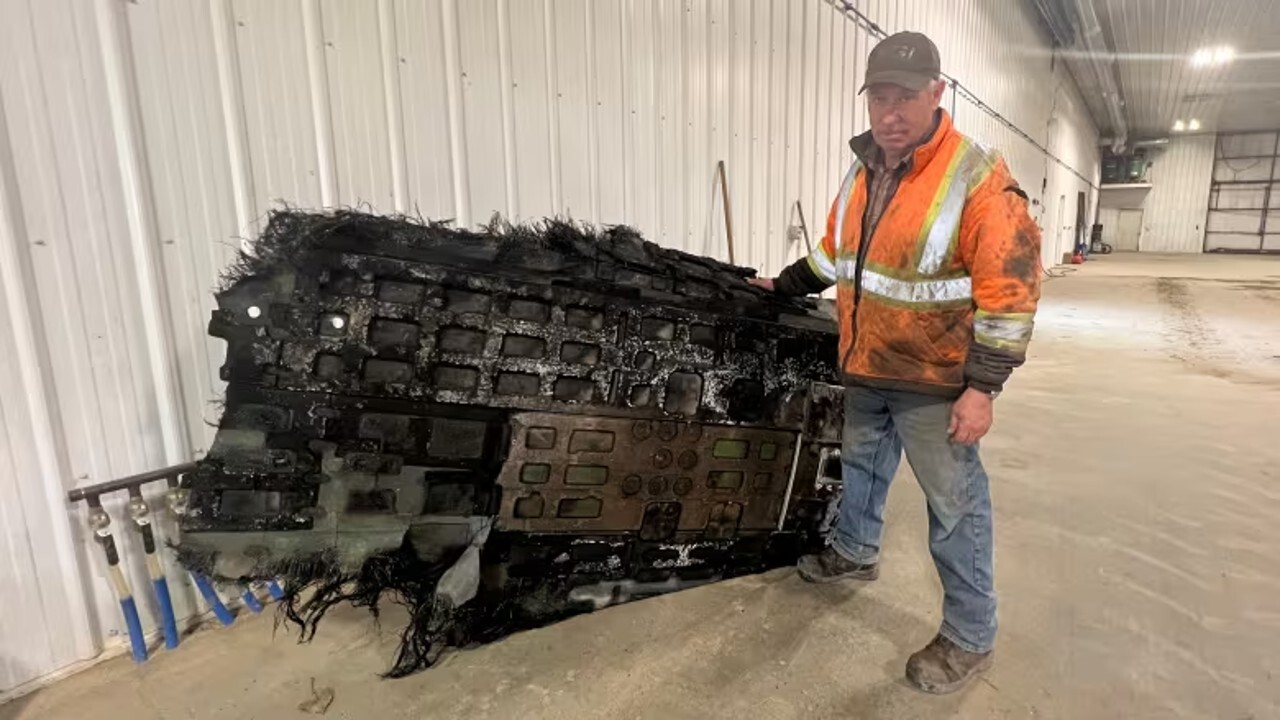Junk from a SpaceX Dragon 'trunk' may have crashed into a Canadian farmer's field (photos)
If confirmed, it wouldn't be the first time a chunk of Crew Dragon trunk crashed to Earth.

Pieces of a SpaceX spacecraft might have landed in Saskatchewan.
A charred piece of debris, possibly from a SpaceX Crew Dragon spacecraft, was found in a Canadian farmer's field in a town northeast of Regina, one of the largest cities in the prairie province.
"We knew it came from the sky, because it couldn’t get there by itself," Barry Sawchuk, owner of the land on which it fell, told the Saskatoon Star-Phoenix of the charred and giant black piece he discovered while seeding in late April.
CBC News, which also interviewed Sawchuk, said the fragment was six feet (two meters) wide and weighs 90 pounds (40 kg). SpaceX has not confirmed whether the debris is from them, but a ground track from a Crew Dragon "trunk" (storage compartment) re-entry in February suggests it is plausible.
Related: SpaceX counters FAA claims that its reentering Starlink satellites could hurt or kill people
Jonathan McDowell, who tracks space launches and re-entries, posted on X (formerly Twitter) that the trunk from the private Axiom Space Ax-3 mission fell over Saskatchewan on Feb. 26.
"Looks like bits of it have been found on the ground," wrote McDowell, who is also an astrophysicist with the Harvard & Smithsonian Center for Astrophysics, of the SpaceX trunk.
Breaking space news, the latest updates on rocket launches, skywatching events and more!
Saskatchewan has rather deep snow and no crops grow there during the winter, both of which mean that Sawchuck would not have spotted the debris until planting season came around and he was working in the fields.
If confirmed, this would not be the first time a trunk made it through Earth's atmosphere. Back in August 2022, a fragment from Dragon was found in a rural Australian sheep paddock (the find was confirmed by SpaceX and the Australian Space Agency).
Benjamin Reed, senior director of SpaceX's human spaceflight program, addressed the debris during a livestreamed NASA Crew-5 press briefing that August. He said there were "no injuries, no damage" associated with the reports and that the debris fell in "an expected path of where things may come down."
"We use models that are ultimately approved, to predict and plan for these things," added Reed, emphasizing SpaceX works closely with NASA and the Federal Aviation Administration or FAA (which licenses launches in the United States) with such matters.
"The trunk segment … typically burns up in the atmosphere over the open ocean posing minimal risk to public safety," the FAA added in its own statement to CNN at the time.
Debris from a SpaceX launch in April 2021 was also found on a central Washington farm, although this one was from the second stage of a Falcon 9 rocket. The Grant County Sheriff's Office confirmed it was SpaceX hardware, although the California company did not respond to comment back then.
Space debris, if it causes injuries or damage, technically can be covered under a section of the United Nations' Outer Space Treaty popularly known as the Space Liability Convention.
A claim under that treaty has only been invoked once, after the nuclear-powered Soviet Kosmos 954 satellite fell in the far north of Canada in 1978, requiring years of pricey cleanup in the ecologically sensitive area that is home to numerous Indigenous groups. Moscow settled with the Canadian government for $3 million CAD in 1981; that's roughly $10 million CAD today, or $7.3 million USD with current exchange rates.

Elizabeth Howell (she/her), Ph.D., was a staff writer in the spaceflight channel between 2022 and 2024 specializing in Canadian space news. She was contributing writer for Space.com for 10 years from 2012 to 2024. Elizabeth's reporting includes multiple exclusives with the White House, leading world coverage about a lost-and-found space tomato on the International Space Station, witnessing five human spaceflight launches on two continents, flying parabolic, working inside a spacesuit, and participating in a simulated Mars mission. Her latest book, "Why Am I Taller?" (ECW Press, 2022) is co-written with astronaut Dave Williams.

